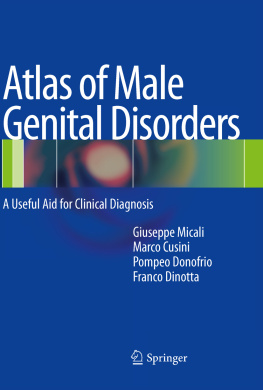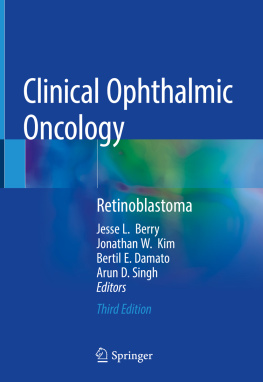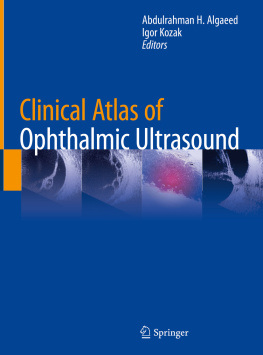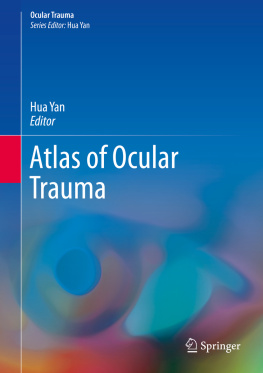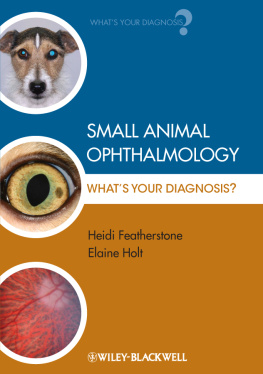
Table of Contents
List of Illustrations
- Chapter 01
- Chapter 02
- Chapter 03
- Chapter 04
- Chapter 05
- Chapter 06
- Chapter 07
- Chapter 08
- Chapter 09
- Chapter 10
- Chapter 11
- Chapter 12
- Chapter 13
- Chapter 14
- Chapter 15
- Chapter 16
- Chapter 17
- Chapter 18
- Chapter 19
Guide
Pages
Color Atlas of Veterinary Ophthalmology
Second Edition
Kirk N. Gelatt
Distinguished Professor of Comparative Ophthalmology Emeritus,
Department of Small Animal Sciences,
College of Veterinary Medicine, University of Florida,
Gainesville, FL, USA
and
Caryn E. Plummer
Associate Professor of Comparative Ophthalmology and Service Chief,
Veterinary Ophthalmology Service,
Department of Small Animal Clinical Sciences,
College of Veterinary Medicine, University of Florida,
Gainesville, FL, USA
This edition first published 2017 2017 by John Wiley & Sons, Inc.
Registered Office
John Wiley & Sons Ltd, The Atrium, Southern Gate, Chichester, West Sussex, PO19 8SQ, UK
Editorial Offices
9600 Garsington Road, Oxford, OX4 2DQ, UK
The Atrium, Southern Gate, Chichester, West Sussex, PO19 8SQ, UK
1606 Golden Aspen Drive, Suites 103 and 104, Ames, Iowa 50010, USA
For details of our global editorial offices, for customer services and for information about how to apply for permission to reuse the copyright material in this book please see our website at www.wiley.com/wileyblackwell
The right of the authors to be identified as the authors of this work has been asserted in accordance with the UK Copyright, Designs and Patents Act 1988.
All rights reserved. No part of this publication may be reproduced, stored in a retrieval system, or transmitted, in any form or by any means, electronic, mechanical, photocopying, recording or otherwise, except as permitted by the UK Copyright, Designs and Patents Act 1988, without the prior permission of the publisher.
Designations used by companies to distinguish their products are often claimed as trademarks. All brand names and product names used in this book are trade names, service marks, trademarks or registered trademarks of their respective owners. The publisher is not associated with any product or vendor mentioned in this book. It is sold on the understanding that the publisher is not engaged in rendering professional services. If professional advice or other expert assistance is required, the services of a competent professional should be sought.
The contents of this work are intended to further general scientific research, understanding, and discussion only and are not intended and should not be relied upon as recommending or promoting a specific method, diagnosis, or treatment by health science practitioners for any particular patient. The publisher and the author make no representations or warranties with respect to the accuracy or completeness of the contents of this work and specifically disclaim all warranties, including without limitation any implied warranties of fitness for a particular purpose. In view of ongoing research, equipment modifications, changes in governmental regulations, and the constant flow of information relating to the use of medicines, equipment, and devices, the reader is urged to review and evaluate the information provided in the package insert or instructions for each medicine, equipment, or device for, among other things, any changes in the instructions or indication of usage and for added warnings and precautions. Readers should consult with a specialist where appropriate. The fact that an organization or Website is referred to in this work as a citation and/or a potential source of further information does not mean that the author or the publisher endorses the information the organization or Website may provide or recommendations it may make. Further, readers should be aware that Internet Websites listed in this work may have changed or disappeared between when this work was written and when it is read. No warranty may be created or extended by any promotional statements for this work. Neither the publisher nor the author shall be liable for any damages arising herefrom.
Library of Congress CataloginginPublication Data
Names: Gelatt, Kirk N., author. | Plummer, Caryn E., 1976 author.
Title: Color atlas of veterinary ophthalmology.
Description: Second edition / Kirk N. Gelatt and Caryn E. Plummer. | Ames, Iowa : John Wiley & Sons, Inc., 2017. | Includes bibliographical references and index.
Identifiers: LCCN 2016046894 (print) | LCCN 2016048984 (ebook) | ISBN 9781119239444 (cloth) | ISBN 9781119239666 (pdf) | ISBN 9781119239673 (epub)
Subjects: LCSH: Veterinary ophthalmologyAtlases. | MESH: Eye Diseasesveterinary | Diagnostic Techniques, Ophthalmologicalveterinary
Classification: LCC SF891 .G45 2017 (print) | LCC SF891 (ebook) | NLM SF 891 | DDC 636.089/77dc23
LC record available at https://lccn.loc.gov/2016046894
A catalogue record for this book is available from the British Library.
Wiley also publishes its books in a variety of electronic formats. Some content that appears in print may not be available in electronic books.
Cover images: Courtesy of Caryn E. Plummer
Preface
Based on the success of the publication of the first edition of Veterinary Ophthalmology in 1981, subsequent editions were released in 1991, 1999, 2007, and 2013. The continued expansion and more rapid development of veterinary ophthalmology worldwide resulted in the current fifth edition having 35 chapters, 64 authors, and a text of more than 2100 pages. This second edition of the color atlas presents diseases based on their clinical appearances, and provides introductory information to complement the photos to further understand the characteristics of each disease. The most common eye diseases are emphasized, but to be inclusive, the less frequent diseases (and species) have been added.
Ophthalmology is heavily based on direct clinical examination and diagnostics, and hence often photographed. This heavily pictorial text introduces the veterinary medical student and veterinary practitioner to clinical veterinary ophthalmology based on the clinical appearances of the diseases that one would encounter in small and large animal practice. When possible, multiple photographs of selected ophthalmic diseases are included to demonstrate the different stages of these diseases as presented to the clinician, and when medical and/or surgical therapies alter their appearance. In contrast to most color atlases, we have provide a comprehensive text describing each ophthalmic disease (history, clinical findings, diagnosis, recommended therapy, and prognosis) as well as many species, including dog, cat, horse, cattle, and exotic animals. As a result, this color atlas has the largest collection of clinical photographs currently available in a single book, and for many readers a reasonably complete ophthalmic reference for your veterinary medical library and clinic.
This second edition has added chapters and more than doubled the color clinical photographs from the first edition. The first two new chapters are divided into: clinical anatomy with emphasis on the gross morphology and ophthalmic structures the clinician encounters during his/her clinical examination, and ophthalmic diagnostics most useful in general practice. ). Appendix 1 is a glossary or condensed selection of ophthalmic words, to assist the reader with sometimes confusing nomenclature (derived from the Greek rather than Latin).
Next page

